Selection of the Most Scenic Viewpoints on an Island Based on Space–Time Perception: The Case of Nan’ao Island, China
Abstract
:1. Introduction
2. Research Methods and Data Sources
2.1. Overview of the Study Area
2.2. Research Design
2.2.1. Preliminary Selection of Scenic Viewpoints
2.2.2. Construction of a Landscape Temporal and Spatial Perception Model
Measurement of Visual Landscape Quality Indicators
Observation Site Accessibility Measurement
Best Viewing of Sunrise and Sunset in Different Seasons
Landscape Temporal and Spatial Perception Evaluation Model
2.2.3. Network Analysis Model Construction
2.3. Data source and Processing
3. Results and Analysis
3.1. View Range Analysis of Scenic Viewpoints
3.1.1. Analysis of Visual Area
3.1.2. Analysis of Visual Richness
3.1.3. Analysis of Marked Landscape
3.2. Accessibility Analysis of Scenic Viewpoints
3.3. Diurnal Analysis in Different Seasons
3.4. The Best Site Selection for Scenic Viewpoints
3.5. Island Scenic Route Layout
4. Discussion
- (1)
- The seasonal effect on island tourism is significant. Considering the uniqueness of island tourism development and the impact of climate conditions on tourism, this studies selects view field factors, accessibility factors, and seasonal variation factors from the perspective of time and space to analyze the spatiotemporal characteristics of a landscape, and constructs the spatiotemporal differentiation characteristics of landscape perception as the basis for site selection and route optimization of scenic viewpoints.
- (2)
- Through the construction of a spatiotemporal perception model of the landscape, it is proposed that different observation platforms and sightseeing routes should be designed according to various types of scenic viewpoints, and tourists should be guided to carry out different types of sensory experiences on a tour. These options provide new ideas and methods for island tourism planning, especially island scenic viewpoint and sightseeing route design. This method can provide an effective reference for island tourism landscape protection, tourism development planning, and other aspects, and enrich existing island tourism planning methods.
5. Conclusions
Author Contributions
Funding
Conflicts of Interest
References
- Kokologos, D.; Tsitoura, I.; Kouloumpis, V.; Tsoutsos, T. Visual impact assessment method for wind parks: A case study in Crete. Land Use Policy 2014, 39, 110–120. [Google Scholar] [CrossRef]
- Kurniawan, F.; Adrianto, L.; Bengen, D.G.; Prasetyo, L.B. The social-ecological status of small islands: An evaluation of island tourism destination management in Indonesia. Tour. Manag. Perspect. 2019, 31, 136–144. [Google Scholar] [CrossRef]
- Yu, C.P.; Huang, Y.C.; Yeh, P.F.; Chao, P. Residents’ attitudes toward island tourism development in Taiwan. Isl. Stud. J. 2017, 12, 159–176. [Google Scholar] [CrossRef]
- Asmit, B.; Syahza, A.; Riadi, R.M. Opportunities and Prospect for Tourism Development on Rupat Island, Indonesia. Folia Geogr. 2020, 62, 133–148. [Google Scholar]
- Chen, H.S. Establishment and application of an evaluation model for orchid island sustainable tourism development. Int. J. Environ. Res. 2019, 16, 755. [Google Scholar] [CrossRef] [Green Version]
- Yang, J.; Ge, Y.; Ge, Q.; Xi, J.; Li, X. Determinants of island tourism development: The example of Dachangshan Island. Tour. Manag. 2016, 55, 261–271. [Google Scholar] [CrossRef]
- Ozkan, U.Y. Assessment of visual landscape quality using IKONOS imagery. Environ. Monit. Assess. 2014, 186, 4067–4080. [Google Scholar] [CrossRef]
- Dramstad, W.E.; Tveit, M.S.; Fjellstad, W.J.; Fry, G. Relationships between visual landscape preferences and map-based indicators of landscape structure. Landsc. Urban Plan. 2006, 78, 465–474. [Google Scholar] [CrossRef]
- Nijhuis, S. GIS-based landscape design research: Stourhead landscape garden as a case study. A+BE Archit. Built Environ. 2015, 5, 1–338. [Google Scholar]
- Ma, K.; Tang, X.L.; Wang, Y.W. Planning and optimization of tour routes in small-scale hilly and mountainous scenic view-point. J. Nanjing Forest. Univ. 2020, 44, 163–170. (In Chinese) [Google Scholar]
- Ginzarly, M.; Roders, A.P.; Teller, J. Mapping historic urban landscape values through social media. J. Cult. Herit. 2019, 36, 1–11. [Google Scholar] [CrossRef]
- Yin, S.; Yang, W.; Kong, Z.H. Extraction method of the best viewing route of traditional villages based on ArcGIS-Taking the world cultural heritage: Kaiping Diaolou and villages as an example. Planner 2015, 1, 90–94. (In Chinese) [Google Scholar]
- Romão, J.; Neuts, B.; Nijkamp, P.; Shikida, A. Determinants of trip choice, satisfaction and loyalty in an eco-tourism destination: A modelling study on the Shiretoko Peninsula, Japan. Ecol. Econ. 2014, 107, 195–205. [Google Scholar] [CrossRef]
- Nijhuis, S. GIS-based landscape design research: Exploring aspects of visibility in landscape architectonic compositions. In Geodesign by Integrating Design and Geospatial Sciences; Lee, D., Dias, E., Scholten, H., Eds.; Springer, Cham: New York, NY, USA, 2014; pp. 193–217. [Google Scholar]
- Yan, Y.; Ju, H.; Zhang, S.; Chen, G. The Construction of Ecological Security Patterns in Coastal Areas Based on Landscape Ecological Risk Assessment—A Case Study of Jiaodong Peninsula, China. Int. J. Environ. Res. 2021, 18, 12249. [Google Scholar] [CrossRef] [PubMed]
- Salinas Chavez, E.; Delgado Mesa, F.A.; Henthorne, T.L.; Miller, M.M. The Hershey sugar mill in Cuba: From global industrial heritage to local sustainable tourism development. J. Herit. Tour. 2018, 13, 426–439. [Google Scholar] [CrossRef]
- Han, G.S.; Kim, S.; Ham, K.M. The Process and Method to Set a Mountainous Scenic Site’s Designated Area. J. For. Environ. Sci. 2020, 36, 47–54. [Google Scholar]
- Ministry of Construction of the People’s Republic of China. GB 50298—1999 Code for Planning of Scenic View-Point; China Building Industry Press: Beijing, China, 2008. (In Chinese) [Google Scholar]
- Yu, K.J. Landscape: Culture, Ecology and Perception; Science Press: Beijing, China, 1998. (In Chinese) [Google Scholar]
- Park, J.K.; Das, A.; Park, J.H. A new approach to estimate the spatial distribution of solar radiation using topographic factor and sunshine duration in South Korea. Energy Convers. Manag. 2015, 101, 30–39. [Google Scholar] [CrossRef]
- Gan, Y.H.; Luo, T.; Zhang, T.H.; Zhang, T.; Qiu, Q. Changes of visual and acoustic landscape along urban-rural gradients and their influence on landscape evaluation. Environ. Sci. Technol. 2013, 36, 347–354. [Google Scholar]
- Eby, D.W.; Molnar, L.J. Importance of scenic byways in route choice: A survey of driving tourists in the United States. Transp. Res. Part A Policy Pract. 2002, 36, 95–106. [Google Scholar] [CrossRef]
- Tenerelli, P.; Püffel, C.; Luque, S. Spatial assessment of aesthetic services in a complex mountain region: Combining visual landscape properties with crowdsourced geographic information. Landsc. Ecol. 2017, 32, 1097. [Google Scholar] [CrossRef]
- Tiedong, L. Based on GIS Technology of Urban Gardening and Greening Layout Optimization Model. Res. J. Appl. Sci. 2013, 6, 2166–2170. [Google Scholar] [CrossRef]
- Zheng, Y.Y. South Australia Island National Forest Park. East Guangdong For. Sci. Technol. 2000, 1, 24. (In Chinese) [Google Scholar]
- Yin, J.; Yang, W.; Kong, Z.H. ArcGIS Based Scenic Route Design of Traditional Villages: Kaiping Watchtowers Case. Planners 2015, 1, 90–94. (In Chinese) [Google Scholar]
- Ma, L.Q. Characteristics and development mode selection of island-type tourist destinations: Taking Zhoushan Islands as an example. Econ. Geogr. 2011, 31, 1740–1744. (In Chinese) [Google Scholar]
- Hu, C.D.; Li, L.M.; Luo, S.K. Research on the riding experience of scenic roads based on the content analysis of online travel notes—Taking the Sichuan-Tibet line of National Highway 318 as an example. J. Tour. Sci. 2015, 30, 99–110. [Google Scholar]
- Li, J.F.; Li, R.J. Automatic site selection of sight-seeing route in ecotourism destinations based on landscape perception sensitivity. Acta Ecol. Sin. 2012, 13, 3998–4006. (In Chinese) [Google Scholar]
- Wang, Y.B.; Xiao, J.H. Study on ecological compensation standard of island-type tourist destinations based on ecological footprint component method. Chin. J. Popul. Resour. Environ. 2014, 24, 7. (In Chinese) [Google Scholar]
- Ma, H.; Zhang, T.H.; Luo, H.S. Analysis on the change of emergy ecological footprint in rapidly urbanizing coastal areas. J. Ecol. 2018, 38, 8. (In Chinese) [Google Scholar]
- Ma, H.D.; Wang, P.; Wen, Y.B.; Yang, C.X. Evaluation of tourism sustainable development in South Australia Island based on ecological footprint analysis. Ocean Dev. Manag. 2021, 38, 61–66. [Google Scholar]
- Cao, Y.H.; Zhang, N.; Zhang, X.; Zhang, J. Warning dissemination and public response in China’s new warning system: Evidence from a strong convective event in Qingdao City. J. Risk Res. 2021, 3, 1–25. [Google Scholar] [CrossRef]
- Lin, S.H.; Liu, C.M. Data assimilation of island climate observations with large-scale re-analysis data to high-resolution grids. Int J Climatol. 2013, 33, 1228–1236. [Google Scholar] [CrossRef]
- Zhou, B.; Xu, J.M.; Yu, H.; Jin, J.Y. Research progress and enlightenment of island tourism: Take international English journals as an example. China Ecotourism 2021, 11, 548–566. (In Chinese) [Google Scholar]
- Dai, L.F.; Ding, L.Y. Island landscape quality evaluation and eco-tourism development countermeasures: A case study of Pingtan Island, Fujian Province. Natur. Sci. J. Harbin Normal Univ. 2012, 28, 4. (In Chinese) [Google Scholar]
- Xu, F.Y.; Ma, B.; Liu, T.M. Construction and operation of island tourism sustainable development system—from the perspective of the coordination of human-land relationship. Social Sci. 2014, 7, 82–88. (In Chinese) [Google Scholar]
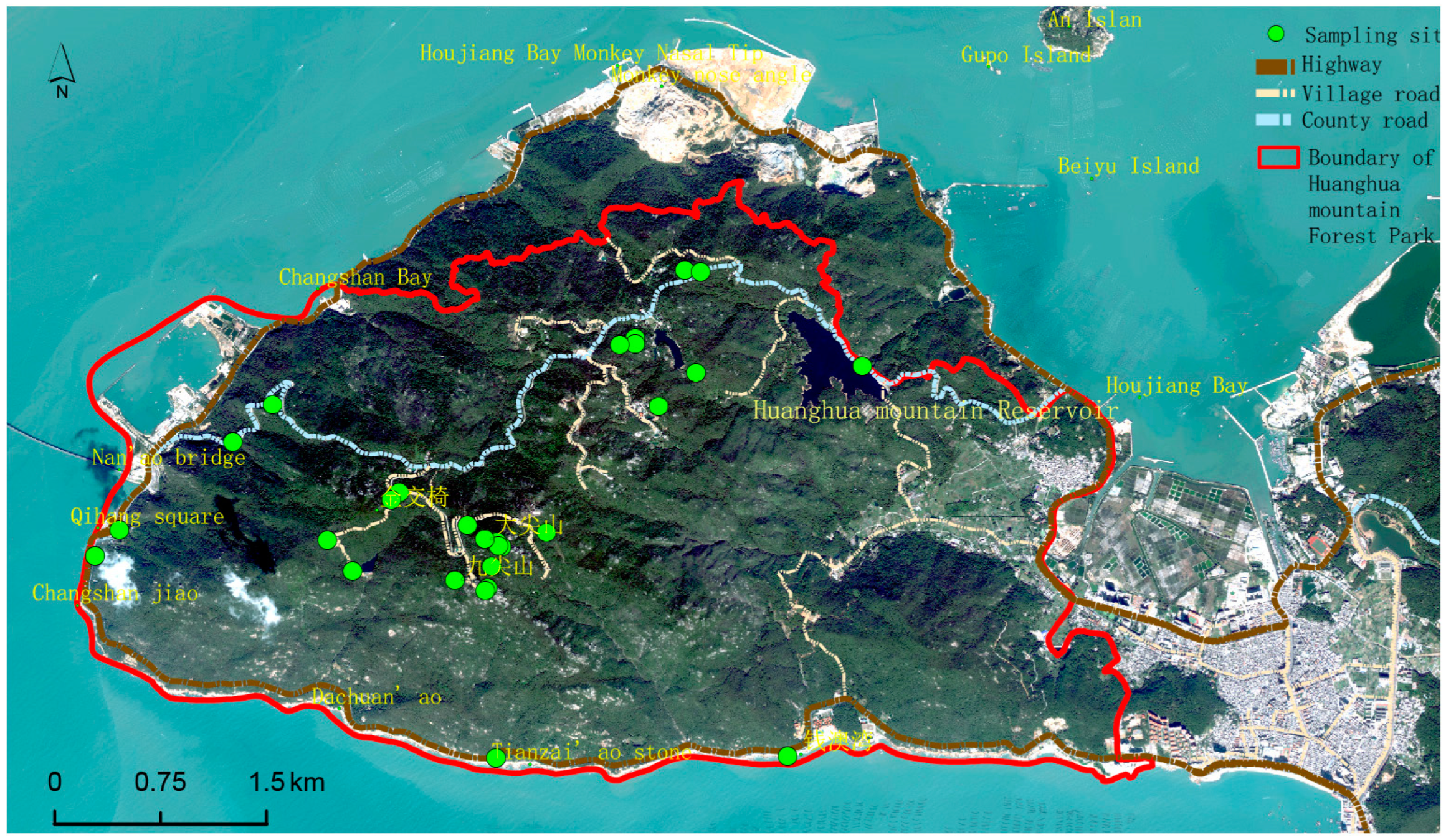
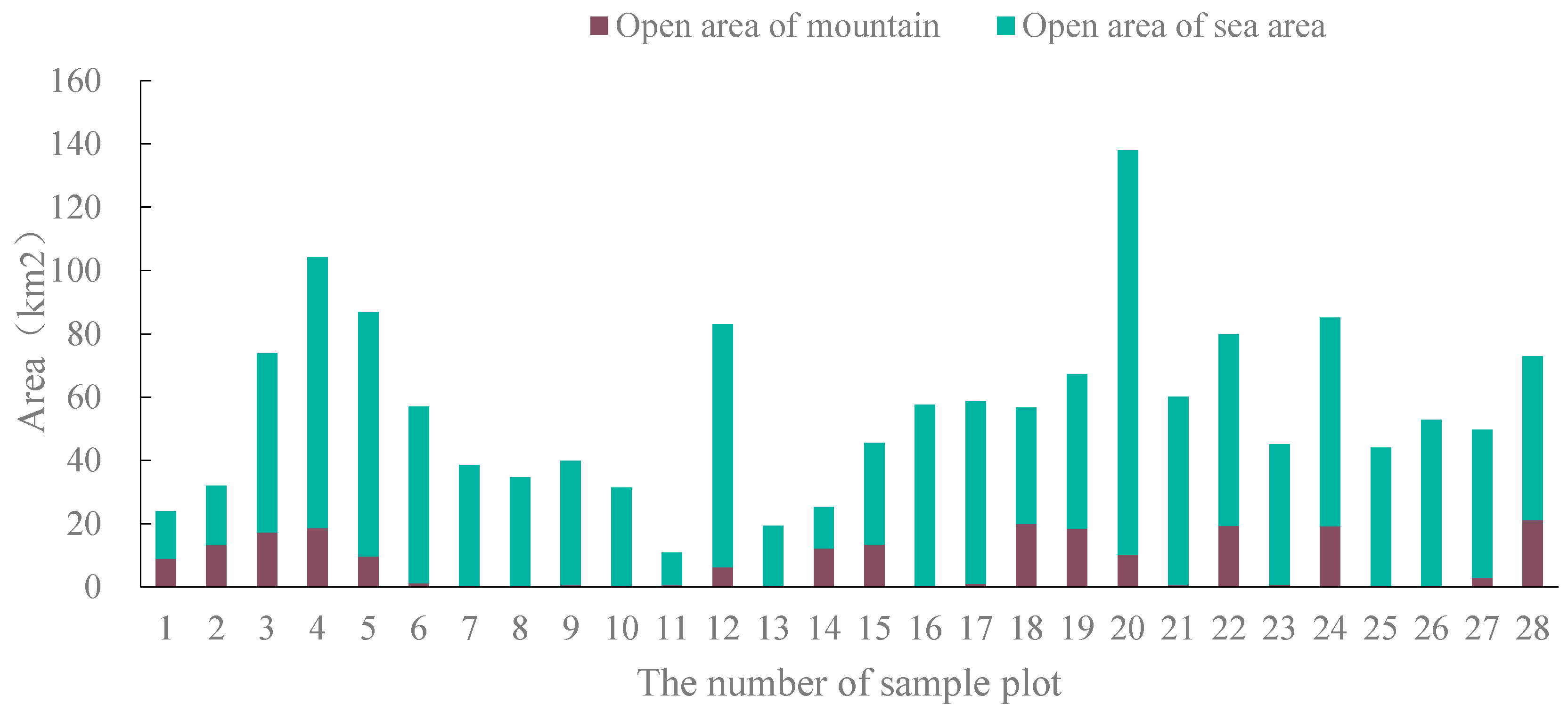


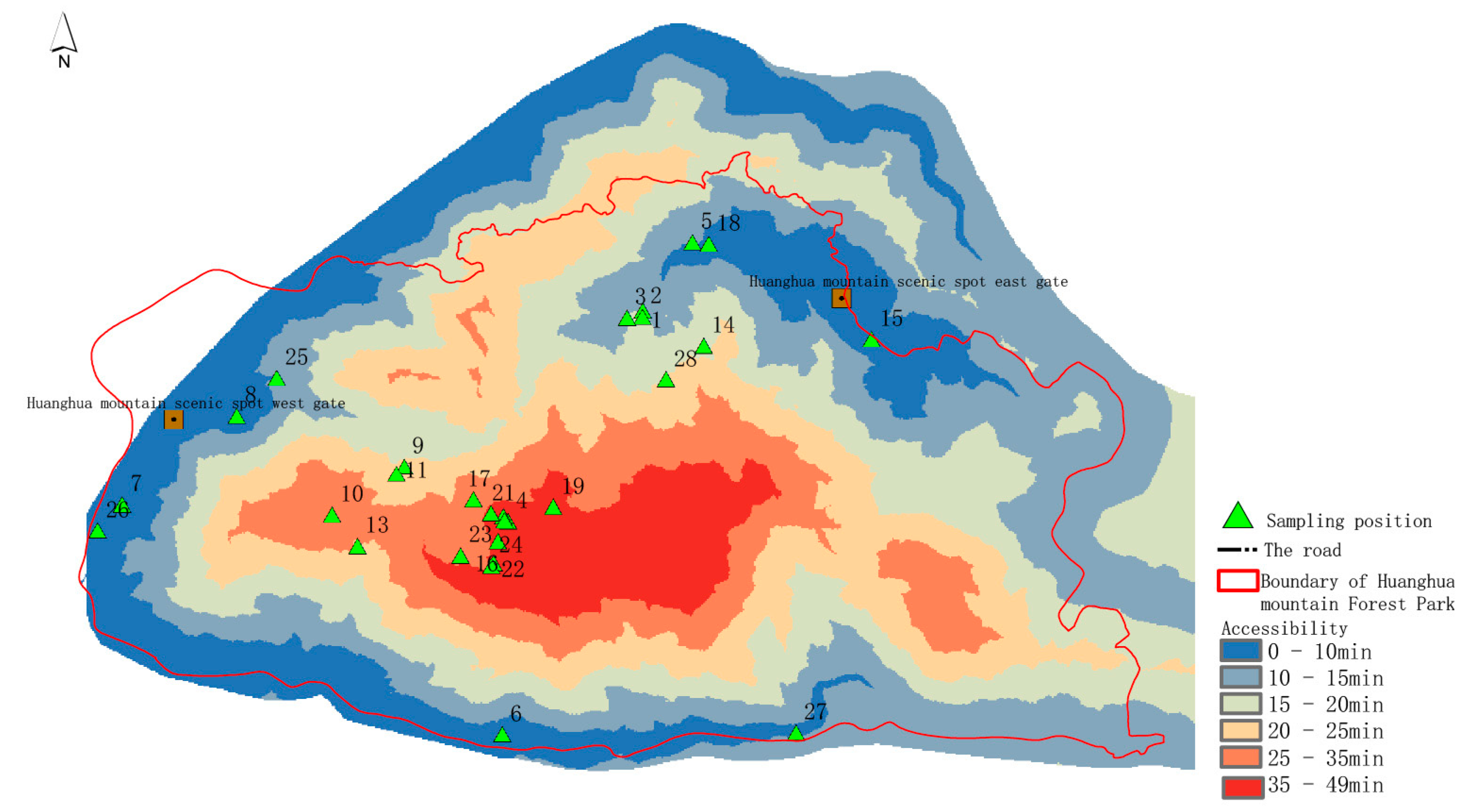
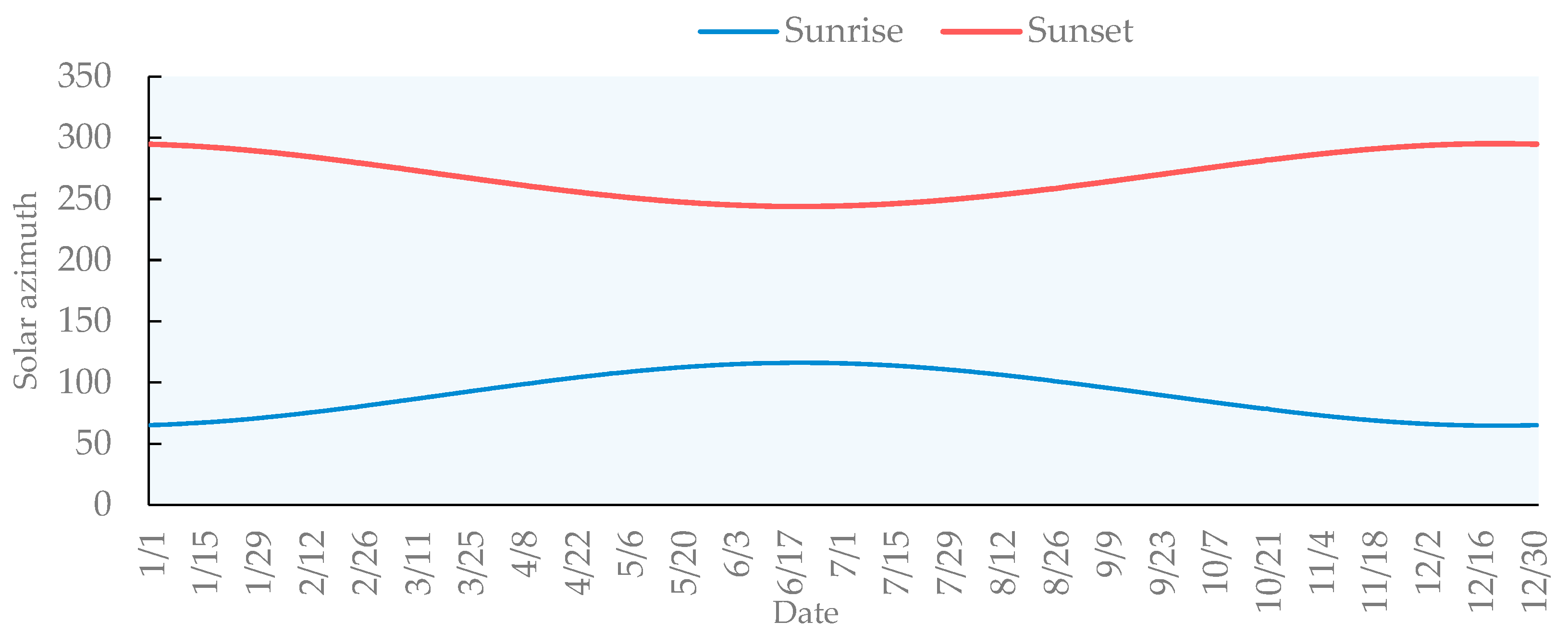
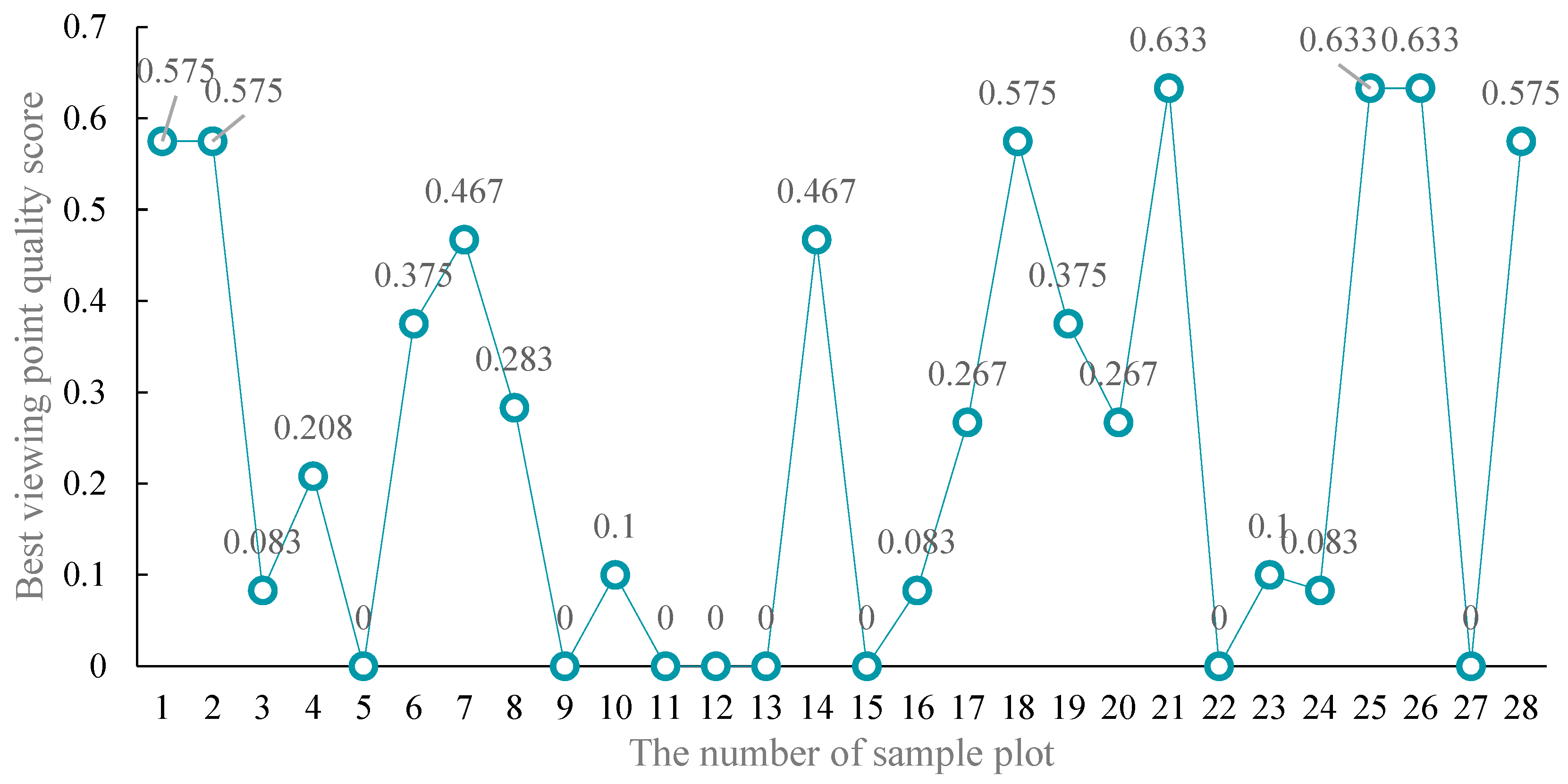
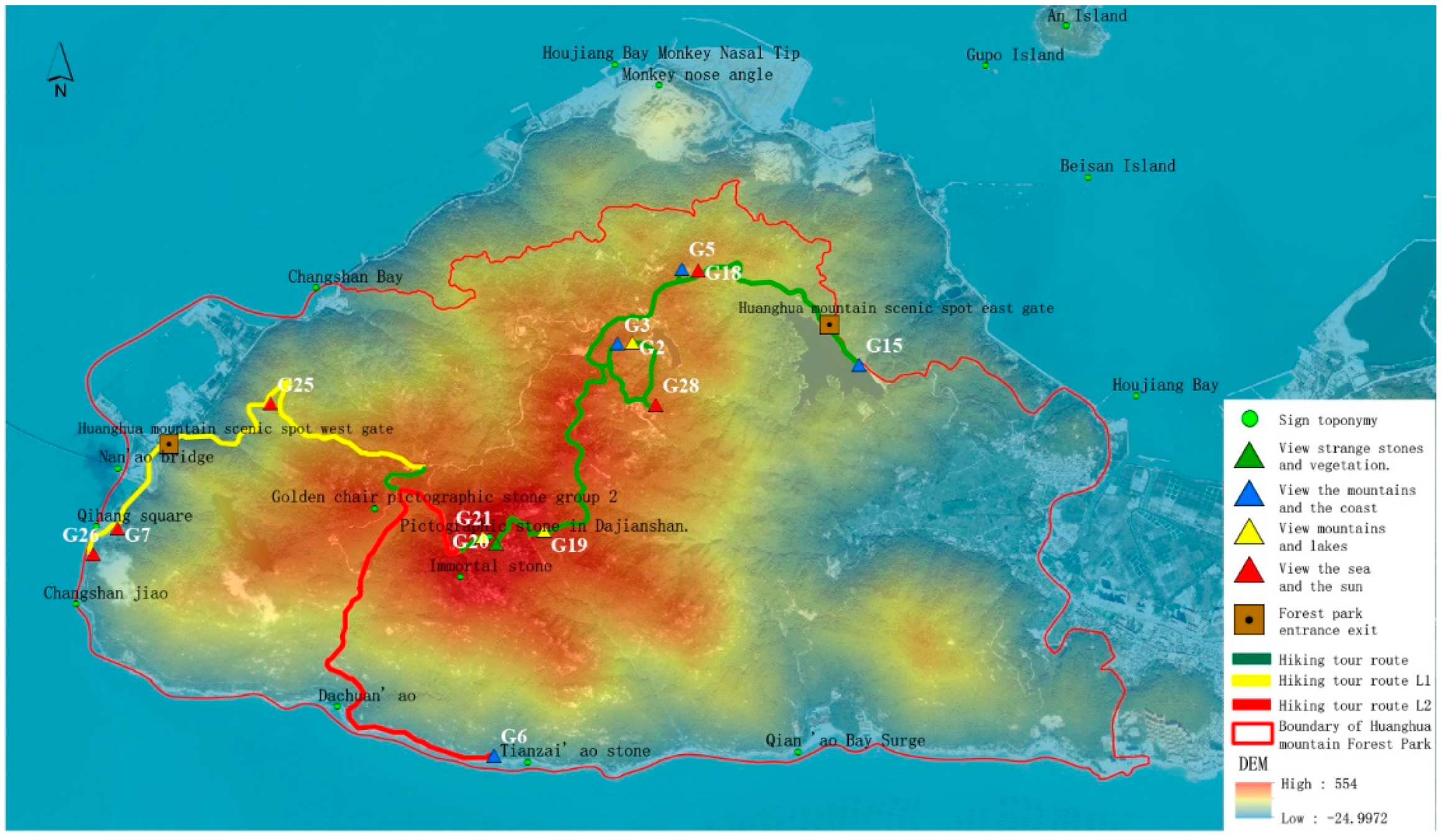
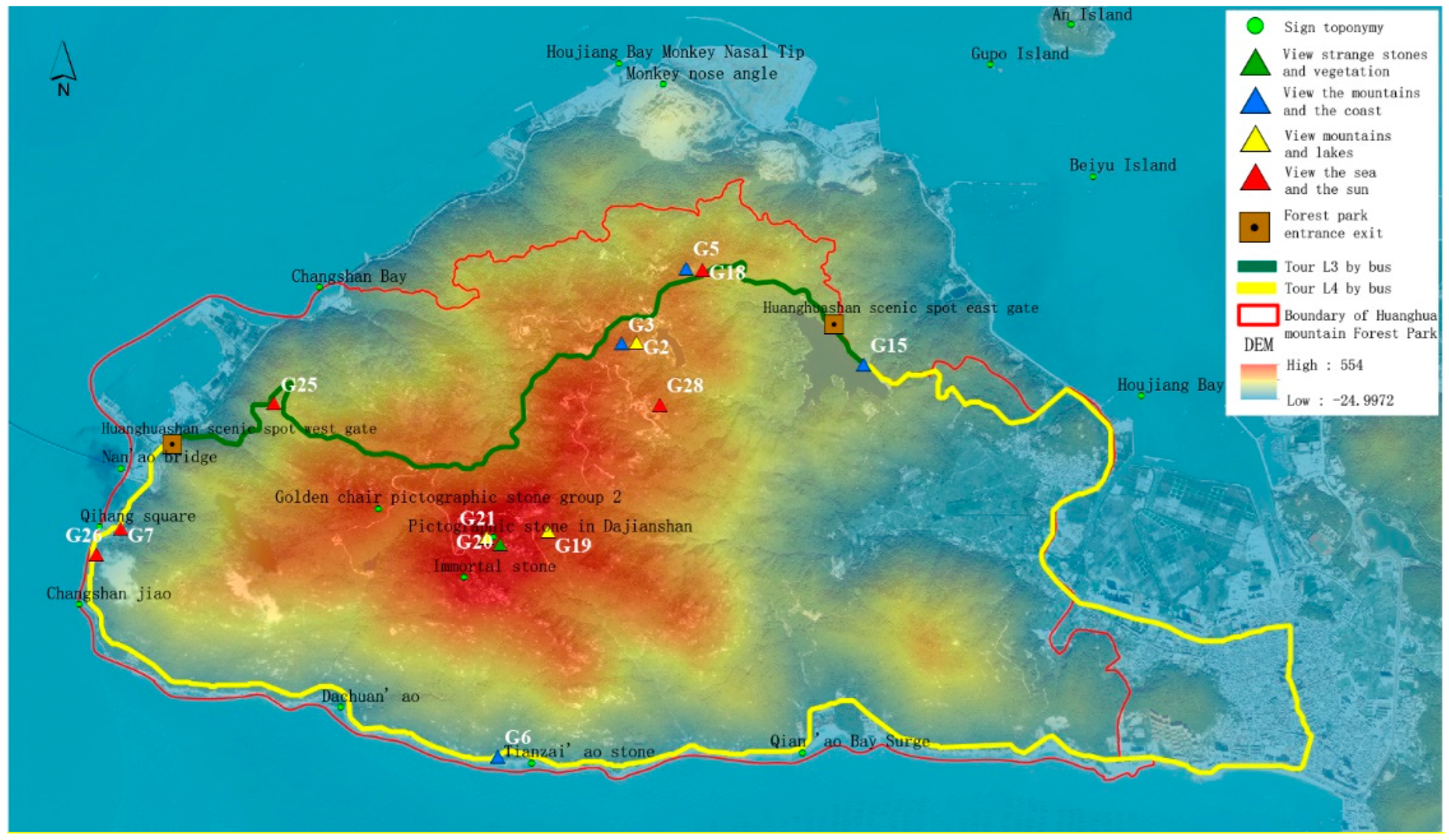
| Terrain Factors | Spatial Feature Description |
|---|---|
| Elevation | The higher the viewing position, the wider the field of view and the better the specific observation effect. The natural commanding point, namely, the top of the mountain, has the highest visibility. The omnidirectional vision and the view space are scattered. |
| Fluctuation | Undulation is an important factor for tourists to view the scenery, as well as a key factor for mountain building site selection and road route selection. |
| Slope | The larger the slope of the landscape surface relative to the viewer’s line of sight, the more likely the landscape is to be seen and noticed [19]. The scenic viewpoints should be arranged on gentle slope areas: a slope less than 15° is a candidate site for viewing. |
| Aspect | Sunshine duration is an important issue to consider when viewing the landscape, which is mainly related to the solar declination, latitude, slope, and aspect of the slope [20]. Generally, the shallower the slope, the longer the sunshine duration; and the steeper the slope, the shorter the sunshine duration [21]. In order to get as much sunshine as possible, the viewing position should be arranged on the south slope and southeast (southwest) slope, avoiding the north-facing back sunny slope. Taking 0° due north and 0–360° clockwise to observe the sea and land and avoid direct light, the optimal slope directions are 315–360° and 30–70° [22]. |
| Space Object | Road | Water Area | Landless Roadless Areas | ||
|---|---|---|---|---|---|
| Provincial Road | County Road | Other Road | |||
| Speed (km/h) | 50 | 30 | 20 | 1 | 5 |
| Time cost (min/km) | 1.2 | 2 | 3 | 60 | 12 |
| Slope/° | Relief Degree/m | |||||||
|---|---|---|---|---|---|---|---|---|
| <5 | 5–15 | 15–25 | >25 | <15 | 15–30 | 30–60 | >60 | |
| Speed (km/h) | 5 | 3.3 | 2 | 1.2 | 5 | 4 | 3.3 | 2 |
| Time cost (min/km) | 12 | 18 | 30 | 50 | 12 | 15 | 18 | 30 |
| Target Layer | Feature Layer | Weight | Evaluation Layer | Weight |
|---|---|---|---|---|
| Spatiotemporal perceptual factor model | Visual landscape quality | 0.527 | Wide field of vision | 0.324 |
| Visual richness | 0.141 | |||
| Number of landmark landscapes | 0.062 | |||
| Accessibility | 0.239 | Ground feature factor | 0.136 | |
| Terrain factor | 0.103 | |||
| Conditions for observing the sun | 0.332 | Sunrise observation | 0.166 | |
| Sunset observation | 0.166 |
| Landscape Type | Landscape | Number of Scenic Viewpoints |
|---|---|---|
| Forest, farmland | Banling Orchard, Guolao Mountain Forest, Huanghua Mountain Forest Farm | 1, 2, 3, 4, 5, 12, 15, 18, 19, 20, 22, 24, 28 |
| Farmland | Banling Shanju Farm, paddy fields, terraced landscape of Yuan Mountain Village | 1, 2, 3, 4, 5, 12, 15, 18, 19, 22, 24, 28 |
| Strange and pictographic rocks | Dajianshan stone group, Dajianshan pictographic stone, Sea Stone, Jinjiaoyi pictographic stone group, Jiujian Mountain stone, Jiujian Mountain Stone Forest, Tianzi’ao stone, Fairy Stone, Eagle Stone | 1, 4, 6, 9, 10, 11, 12, 16, 17, 20, 21, 22, 23, 24 |
| Bridge | Nan’ao bridge | 7,25,26 |
| A-frame | Fengyu lighthouse, lamppost of Changshanwei Wharf | 7, 8, 17, 21, 26 |
| Pond | Guicheng Mountain pond | 1,2 |
| Cultural venues | Guicheng Square, Sailing Square | 1, 2, 3, 7, 26 |
| Small reef | Anzai Island, Beisan Island, Guan Island, Ta Island, Xiafei Island | 1, 2, 4, 5, 6, 12, 13, 14, 15, 16, 18, 19, 20, 22, 24, 27, 28 |
| Image marker | Qianjiangwan Landmark, Nan’ao Visitor Center | 4, 22, 24 |
| Tidal surge and breaking phenomenon | Tianzaiao surge | 6 |
| Recreation area | Houjiang Bay, Qianjiang Bay | 4, 13, 18, 19, 22, 24, 27, 28 |
| Recreational lakes | Huanghua Mountain Reservoir | 18 |
| Season | Time of Sunrise | Serial Number of the Sunrise Sample Sites | Time of Sunset | Serial Number of the Sunset Sample Sites |
|---|---|---|---|---|
| Spring (February–April) | 5:39:21–6:52:17 | 1, 2, 3, 4, 16, 18, 19, 28, 24, 13, 6, 8 | 17:58:27–18:39:31 | 14, 25, 20, 21, 10, 7, 26, 8, 17, 23 |
| Summer (May–July) | 5:24:47–5:41:21 | 18, 1, 2, 28, 19, 4, 6, 13 | 18:39:58–19:02:27 | 14, 21, 25, 7, 26, 20 |
| Autumn (August–October) | 5:42:13–6:15:22 | 18, 1, 2, 28, 19, 6 | 17:35:58–18:54:14 | 14, 21, 7, 26, 25 |
| Winter (November–January) | 6:17:34–6:55:42 | 18, 1, 2, 28, 8 | 17:24:55–17:55:42 | 25, 8, 17, 21, 7, 26 |
| Types | Visual Landscape Features | Sample Number |
|---|---|---|
| Watch the sun and sea | View farmland + view bridge + view island + view sea, enjoy sunrise and sunset all year round, rich landscape levels, broad vision, easy to reach | 26, 18, 28, 25, 7 |
| Watch the mountains and the coast | View farmland + view forest + view island + view tidal surge, spring, summer, and autumn three seasons considerable sunrise, rich landscape level, broad vision, easy to reach | 6, 5, 3, 15 |
| Watch the mountains and the lakes | View reservoir + view forest + view stone + view island + view the sea, the year-round considerable sunrise and sunset, landscape level is general, the field of vision is wider, not easy to reach | 2, 21, 19 |
| Watch unusual or pictographic rocks and vegetation | View the strange stone + view the forest + view the island, spring and summer considerable sunset, landscape level is general, the vision is very broad, not easy to reach | 20 |
Publisher’s Note: MDPI stays neutral with regard to jurisdictional claims in published maps and institutional affiliations. |
© 2022 by the authors. Licensee MDPI, Basel, Switzerland. This article is an open access article distributed under the terms and conditions of the Creative Commons Attribution (CC BY) license (https://creativecommons.org/licenses/by/4.0/).
Share and Cite
Zhang, T.; Zhang, S.; Wang, Y.; Yu, H.; Ju, H.; Xue, H. Selection of the Most Scenic Viewpoints on an Island Based on Space–Time Perception: The Case of Nan’ao Island, China. Int. J. Environ. Res. Public Health 2022, 19, 1309. https://doi.org/10.3390/ijerph19031309
Zhang T, Zhang S, Wang Y, Yu H, Ju H, Xue H. Selection of the Most Scenic Viewpoints on an Island Based on Space–Time Perception: The Case of Nan’ao Island, China. International Journal of Environmental Research and Public Health. 2022; 19(3):1309. https://doi.org/10.3390/ijerph19031309
Chicago/Turabian StyleZhang, Tongyan, Shengrui Zhang, Yingjie Wang, Hu Yu, Hongrun Ju, and Hanyun Xue. 2022. "Selection of the Most Scenic Viewpoints on an Island Based on Space–Time Perception: The Case of Nan’ao Island, China" International Journal of Environmental Research and Public Health 19, no. 3: 1309. https://doi.org/10.3390/ijerph19031309
APA StyleZhang, T., Zhang, S., Wang, Y., Yu, H., Ju, H., & Xue, H. (2022). Selection of the Most Scenic Viewpoints on an Island Based on Space–Time Perception: The Case of Nan’ao Island, China. International Journal of Environmental Research and Public Health, 19(3), 1309. https://doi.org/10.3390/ijerph19031309








